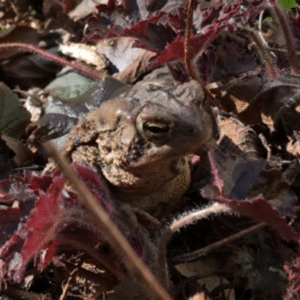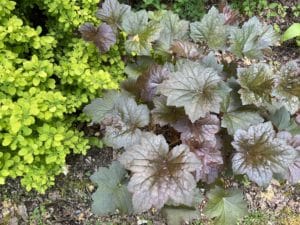Hello fellow readers, Indeed, toads and frogs are beneficial garden guests, each eating a hundred or more insects or slugs every day. And while not all of us have ponds nearby, attracting toads to your garden is doable and fun. But first, may I share a story…
While recording a Garden Dilemmas Podcast episode from the screened porch, a chorus of green frogs, spring peepers, and an American bullfrog were all singing their mating calls. Amongst them was the humming sound of an Eastern American Toad from a nearby garden—perhaps the same little fellow I’ve come upon twice before.
The story of my American toad
Long ago, I had an adored green glazed pot that I hated to throw out after it broke in two. I’m sure you’ve seen garden pots toppled on the side as a garden feature next to a swath of flowers as if they’re spilling out. And so, I did just that, placing the green glazed half next to a cluster of happy Palace Purple Coral Bells (Heuchera ‘Palace Purple’). Call me copycat (smile). Little did I know it would make for a safe getaway for a friendly toad.
The story of my American toad became a column topic a while back (link below). It was during a time the garden became sorely ignored when I wrote:
“There were tears in my eyes as I began tackling what I’d neglected, exaggerated by memories of time and loved ones gone by. I felt unworthy as a gardener, a nurturer of life. Then I knelt before the ‘Palace Purple’ Coral Bells and began weeding. Within minutes a toad jumped by my garden glove. Is that you? I asked out loud.”
I’m sure he was the same little fellow I spied the spring prior when I was scrambling to do fall cleanup. (Not a typo, I was that behind with the circumstances of tending to my failing mom). But, he was plumper than the year before. Likely because of all the slugs he’s taken care of for me. His presence lifted me.
Attracting Toads to your Garden
On their own, toads find cover under loose rocks and logs and nooks in the roots of trees. Then, come winter, they burrow below the soil to hunker down. They are amphibians and, therefore, extremely sensitive to pesticides and insecticides, so forgo nasty chemicals in your yard.

Clay pots are cooler than plastic or metal ones during the heat of the summer. If water isn’t nearby, provide some using the clay saucer that goes with the pot, refreshing the water each week.
My dear Jolee is masterful at pouncing cave crickets. And so I’m concerned she may be intrigued by toads, too—another reason for a toad house to offer a hiding spot. Unbeknownst to me, toads have a defense mechanism against predators, much like skunks.
Toads have a skunk-like defense mechanism.

Sure enough, Jolee spies a toad! To learn the outcome, see Do Cave Crickets Benefit the Garden?
If threatened, some toads secrete a poison that tastes bitter and smells terrible. It can burn a predator’s eyes and nose, though it’s not harmful to humans when picking up a toad. However, it can swiftly cause excessive drooling, foaming at the mouth, even seizures if your canine or feline kid is affected.
Quickly flush out the venom with water rinsing outward and wipe their gums to remove the residue, so your beloved pet doesn’t swallow it. Then, as a precaution, contact your veterinarian. Fortunately, the risk of impact is low here. But for those in the southwestern US, where the Colorado River Toad (Bufo alvarius) and the Marine /Giant Toad (B. marinus) live, the impact can be deadly.
So back to my make-shift toad house. Sure, there ones you can buy, but making your own is more enjoyable. And you can decorate them with paint or markers—a fun activity for your children or big kids like you and me.
Garden Dilemmas?AskMaryStone@gmail.com (and your favorite Podcast App).
Frog & Toad Tidbits:
Did you know that frogs have teeth; toads don’t. Frogs live in or near water; toads on land. Frogs have smooth, slimy skin; toads have warty dry skin, though it’s not true that you can get warts from them. While toads don’t live in the water, they need water to reproduce, such as a small pond or vernal pool that stays filled most of the year.
About Palace Purple Coral Bell:
The foliage of Heuchera ‘Palace Purple’ ranges from olive or bronze-green to deep purple. Sprays of tiny pink bell-shaped flowers rise above, providing a lovely contrast to the dark leaves when in bloom. They prefer part shade but can manage full sun if kept moist. Hardy in zones 4 to 9, they stay evergreen in milder zones, including ours. And, if their self-seeding isn’t enough for you, they can be divided every three to four years in the spring to make more plants.
And, the link to the column mentioned above featuring my American Toad – Healing in the Garden of Life and a related story Frog Watch USA
You can hear the glory of the chorus of frogs and toads in Episode 29 of the Garden Dilemmas Podcast.
Helpful link – The Trouble with Toads: Getting to the Bottom of This Toxic Threat





Love this idea; however, I have one cautionary note.
I created a “toad house” one year; however, when I looked under I found a snake instead of a toad.
And, I’m an ophidiophobe; so I was not happy!
Also, I don’t know if the snake ate the toad.
Another time I had a toad in the house! It must have hopped in my kitchen door when I opened it to go outside. My cats alerted me to its presence under a wheeled wicker storage box in my living room.
Fortunately, I was able to scoop it up using a large dustpan and settle it carefully back on the deck!
It took up brief residence on the deck behind an old picnic basket I was using as a planter.
Oh my, Mary! Your story reads like a harrowing action film. I’m giggling about your cats’ finesse of alerting you of the little fellow–a happy ending for at least one toad.:^). Thanks for sharing. Mary